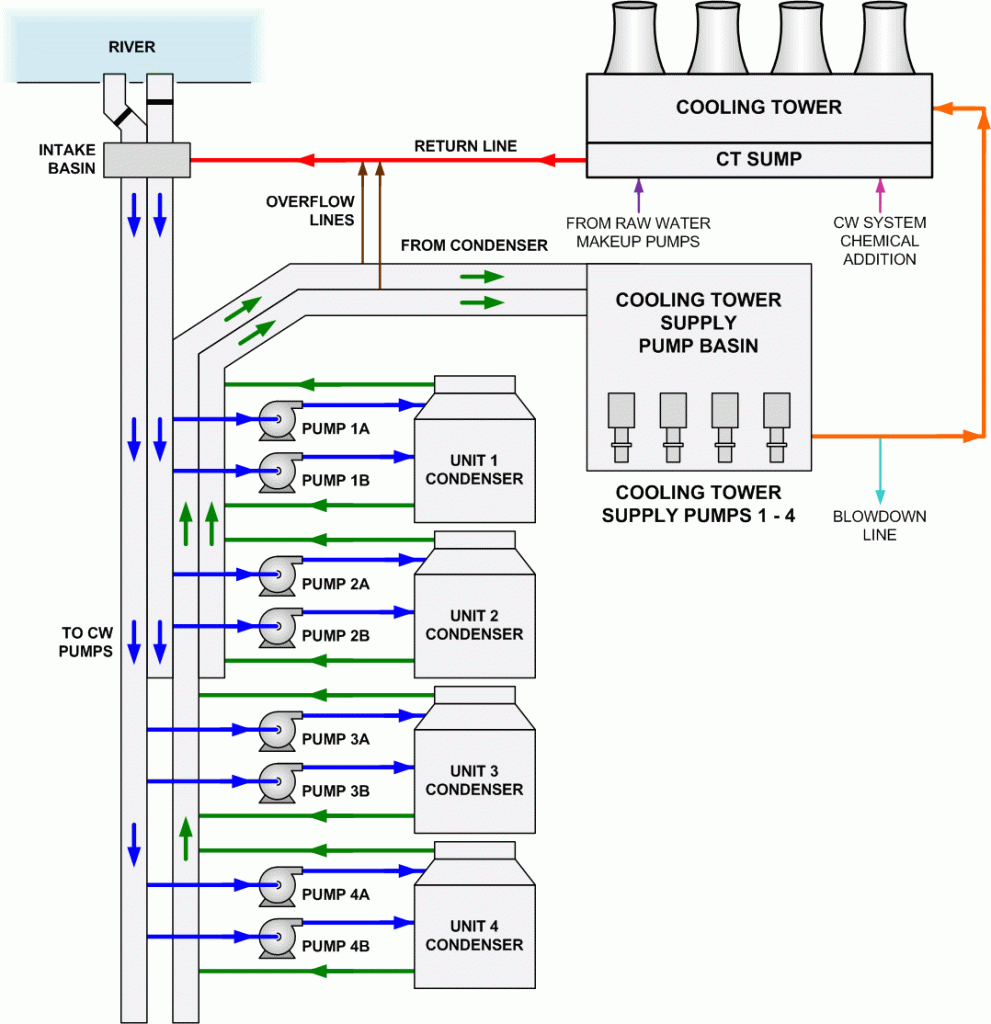
Throughout the power industry, varying skill levels among operators have been commonplace for decades. Every plant has their go-to-guys when the unit must be started up following a lengthy outage. There is always the shift that has fewer issues than the others and is trusted to perform the most complex of operations. Conversely, there is usually a shift that must be closely monitored due to shaky records during abnormal conditions or operations. Comprehensive, performance-based training and qualification programs can close the skill gap between these shifts and ensure a high level of performance across the board at your plant.
A great article by go2HR (2017) discusses how effective employee training and qualification programs are worth the investment for almost every business. The power industry is no exception, which is why managers in the power industry must ensure that they have well developed and effective training and qualification programs in place at their facilities. Effective training and qualification programs in the power industry typically consist of system operations manuals, simplified flow diagrams, study guides, progression testing, job performance measures (JPMs also referred to as task qualification evaluations (TQEs)), and trainee progress cards. The most effective programs also use a simulator to assist in training and evaluating employees. These training and qualification programs are developed after conducting a thorough Training Needs Assessment and/or Job Training Analysis of the Operations organization. These assessments will determine what is necessary to improve job performance. Once an assessment is complete, the facility can begin to develop the appropriate training and qualification programs.
When developing the training and qualification programs, it is important to use up-to-date existing plant documentation and operating knowledge obtained from the most experienced experts on the team. Up-to-date plant documentation must be used in developing the training and qualification program to ensure all important and accurate equipment details are used. Including items which have been previously overlooked, will be helpful to new operators learning their positions. It is also very important to use competent and experienced operators in developing the training and qualification program and validating the results. Many times certain “nuggets” of operating knowledge may only be known by a select few operators who have experienced decades of varying operating scenarios.
Development of training and qualification programs can be done in-house, but is often accomplished by hiring outside training consultants. Where power producers once had large training departments, the competitive nature of the power industry has led to often extreme workforce reductions, including the elimination of in-house training assets. Training consultants with experience in the industry have a wide array of solutions that can be used to create custom or generic training programs, as discussed in a recent article by Craig Woodman (2017). Using a competent training consultant can aid in creating effective performance-based training and qualification programs for the facility. Custom and plant-specific training programs, based on comprehensive and valid needs assessments for the designated audience will ensure that employees are trained on what they need to be trained, and that their training time is not wasted on unnecessary studies and exercises. For example, providing generic training on the properties of coal for a new hire at a gas fired combined-cycle power plant would not be an effective use of the trainee’s or facility’s time.
It is possible to train operators using existing plant documentation as a basic framework, but facility libraries tend to become depleted or poorly maintained over time. For example, at many locations the original plant training materials do not cover the up-to-date control and operation of the plant systems using a distributed control system (DCS). By producing and using up-to-date System Operations Manuals that are both specific to the plant and well-organized, training programs can be much more effective.

Documentation provided by vendors is often overly generic in nature, written for degreed engineers and difficult for the average operator to understand or apply to his or her operating unit. System Operations Manuals that use many photos and other illustrations help trainees to quickly grasp the design and function of each system and component. Further, System Operations Manuals designed with training and qualification in mind can be used to combine all the information a trainee needs to know and understand about every plant system related to their job in a single document. This document can be handed out to trainees at the beginning of their training and qualification program and be used to both guide the trainee in his/her studies and serve as a bench mark for what he/she needs to know. This avoids wasting valuable training time where trainees hunt around the plant searching for up-to-date and relevant reference material to train on.

One of the most important parts of any comprehensive performance-based power plant operations training and qualification program is the ability of a trainee to walk down each plant system he or she is or will be responsible for operating. Operators need to know where the major components, valves, and instrumentation are situated in the plant and the proper flows through the connected piping. Often Plant and Instrumentation Diagrams (P&IDs) for a plant are the original versions provided by the companies which built the plant and are difficult to follow or are out-of-date. When not “afraid” to look at them because of the mass of information typically provided on them, trainees may spend excessive time trying to grasp the function of a system using the associated P&IDs. Using a simplified flow diagram instead that includes directional arrows to indicate flow paths and color coding to trace piping can save the operator much time in learning the system and building his confidence about the overall configuration of the system. Flow diagrams, when developed specifically to suit the needs of the operators eliminate a lot of the unnecessary information that typically clutters up the P&IDs.
Study guides are another tool commonly used in training and qualification programs in the power industry. These documents guide trainees through the various training topics and activities they will need to complete as part of their ongoing training and qualification programs. Sometimes, generic online courses are available to the plants which trainees can use, along with plant-specific training and qualification documents. The study guides direct the trainees toward what courses to take, what to study in the plant documentation, and what to research and walk down in the plant. Review questions for the trainees to self-test their knowledge before being taking qualification exams are also included to aid the trainee in his course of study. Using a standard study guide ensure every trainee receives the same training and is tested on similar material.
Study guides also provide trainees with a way to guide themselves through plant and equipment walk downs and important operational evolutions that must be demonstrated. Many times these evolutions are performed under the direction of experienced, competent operators or supervisors. This approach permits trainees to develop a firm, correct understanding of how each system operates. Observing and monitoring incumbent operators performing their duties and controlling the various plant systems during important startup and shutdown evolutions is essential to trainees learning the job. Being able to discuss operations of vital system components and operations with incumbents and supervisors is a key to success. Study guides listing specific tasks to achieve are a way for each trainee to obtain this necessary knowledge for each system without missing anything that should be learned.
Progression testing is another important aspect of comprehensive, performance-based training programs. Performance testing allows trainees to be tested periodically on what they have learned at each step or level in the program. If a trainee is struggling at certain points or throughout the training program, the trainee’s supervisor should be able to recognize any deficiencies to aim the trainee toward successful program completion. Progression testing also prevents trainees from proceeding to a next stage of the training and qualification program until they have become well versed in the knowledge, skills and tasks associated with the earlier stage.
Classroom or Computer/Web-Based training is frequently used in to familiarize trainees with plant fundamentals, basic system configuration, controls and operations. Completion of this training ensures all trainees in the program have the foundational or core knowledge important in performing the job. Classroom training is preferred by many because an instructor can enhance the educational experience by asking and answering multiple questions as the training proceeds and as he or she identifies additional trainee developmental needs. On the other hand, many people and organizations prefer computer or web-based training (Coffey, 2016), especially when used with a Learning Management System (LMS) as it reduces the administrative burden of implementing the training. Although this type of training can be somewhat interactive, it will not be to the same extent as having a professional instructor. Online training with an LMS can grade quizzes and tests, record the results and create a permanent record of the training automatically for each trainee.

Many power generation facilities choose to procure an operator training simulator (OTS) and incorporate it into their control room operator training and qualification programs. Some organizations choose to invest in a high-fidelity simulator that functionally exactly replicates their plant, while others choose to invest in a lower fidelity simulator that serves to familiarize trainees with plant controls. Lower fidelity simulators do not respond exactly how the plant would respond. Regardless, both types can be valuable tools to enhance the trainee’s learning experience, increasing knowledge and skill retention and ensuring the overall effectiveness of the control room operator training and qualification program.
It is important in either case that the simulator be used within a formal, structured training program that ensures the operators learn the essential knowledge associated with the plant’s controls. Other things that can be trained on the simulator include effective efficient plant operations and developing or improving the skills to safely operate the unit during both normal and abnormal operating conditions. A structured simulator training program will reduce the time needed for training, maintain the trainees’ interest to participate in the training, and ensure all aspects of the job are taught. This will ensure the trainee is able retain the necessary knowledge and skills to successfully operate their unit(s).

Rendered image of a high-fidelity control room simulator.
Another reason simulators are valuable as a training tool is because they allow trainees to learn important operational tasks before attempting them on the actual operating unit (Dr. Johnstone, 2013). For example, a trainee can start up and place the unit online via the simulator a dozen times before conducting an actual plant startup. This familiarizes the trainee with both the plant controls and the operating procedures associated with a unit startup or shutdown. In addition, the simulator allows the operators in training to experience abnormal operating malfunctions and practice the appropriate responses in a pure training environment with no chance of damaging the plant. For example, a trainee can learn about and practice response to steam turbine valve failures without any concern about overspeeding the steam turbine on the simulator. Obviously, performing any exercise on the actual unit that could result in an overspeed condition on the main turbine could, beyond testing the turbine protection, have disastrous consequences.
Another aspect of using a simulator that is valuable to the training and qualification process is their capability to allow detailed objective monitoring and evaluating trainees’ performance. Many simulators in use in the power industry today can be programmed by the instructor to test operators during specific plant operating scenarios, such as startup, shutdown and abnormal conditions. For example, a simulator can be set up to test operators on conducting a boiler heatup while it monitors critical temperatures, pressures and drum level continuously. Once the exercise is complete, the simulator instructor can print a report that documents the performance of the trainee and his or her ability to maintain the critical parameters within their desired limits. This report can be a useful resource or tool in enhancing the learning experience of the trainee and helping them to overcome problem areas in their development.
To ensure operators have developed the requisite skills and ability to properly staff a position at a power generation unit or facility, they should be evaluated in their performance of various plant evolutions that are key to success at the job. Comprehensive, performance-based training and qualification programs in the power industry typically utilize job performance measures (task qualification evaluations) to perform these assessments. Important plant evolutions and operations are identified for each job and experienced operators or supervisors evaluate trainees using JPM evaluation forms. The JPMs ensure trainees are able to satisfactorily perform the plant evolution on their own.
Although the study guides used in the training and qualification programs lay out what is necessary for trainees to qualify for a job, it can be cumbersome for the trainee’s supervisor to track what has completed. To alleviate this, comprehensive performance-based training and qualification programs utilize trainee progress cards (TPCs) to track where individual trainees are within the training program. These are sometimes referred to as “Qual Cards” and list everything that is required of a trainee to qualify a position at a power plant. As the trainee completes each task required for their training and qualification, the item is checked off so that both the trainee and his/her supervisor can track progress through the program. If the organization uses an LMS, they may be able to track the progress within the LMS system.
The benefits to training power plant operators within a defined scope are obvious. It is also important to understand that some states require facilities to certify plant personnel for continued operations. Requirements for certification to operate a steam plant vary significantly from state to state. Some states require a license, such as the state of Maryland, which requires a Grade 1 Stationary Engineers license to operate a 500 HP and greater boiler (Mayland.gov, 2017). Many other states require no licensing. When licensing is required, the associated knowledge requirements should be incorporated into the qualification program to ensure that the plant is meeting all legal requirements to operate.
Utilizing a comprehensive, performance-based training and qualification program at power generation facilities can greatly benefit both the operators and plant/utility management. After implementing such a program, knowledge gaps across shifts should start to close, and fewer operational mistakes will occur. This allows for safer, more efficient operation of the power plant which reduces costs and improves operational readiness and availability. Implementation will further benefit management by allowing more flexible scheduling of resources since, over time, all shifts will be at or near full qualification. Plant management at power generation facilities should take a hard look at their operations organization to determine if developing a comprehensive performance-based training and qualification program is right for the organization.